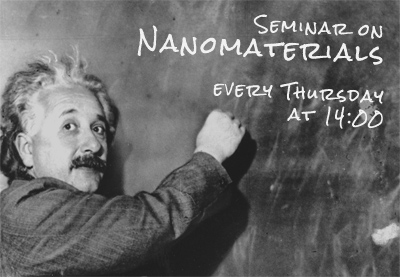Nanoseminar
Group of Structure analysis at the Department of Condensed Matter Physics
of Charles University and MGML has a pleasure to invite you to attend the seminar on nanomaterials: Physics, Technology, Applications
on 13th November 2025 at 14:00
at Faculty of Mathematics and Physics of Charles University, Ke Karlovu 5, 121 16 Praha 2
Lecture room F2
Tereza Košutová
Department of Condensed Matter Physics
Thin films prepared by ion-assisted sputter-deposition – the correlation of electric/mechanical properties with structure
Tereza Košutová » Thin films prepared by ion-assisted sputter-deposition – the correlation of electric/mechanical properties with structure
Department of Condensed Matter Physics
Location: F2
Thin films prepared by ion-assisted sputter-deposition – the correlation of electric/mechanical properties with structure
Tereza Košutová1, Y. Yao1, Z. Zhang1, F. Gustavo2, F. Lefloch2, D. Drozdenko3, P. Dobroň3, M. V. Tavares da Costa4, K. Gamstedt4, S.- L. Zhang1, T. Kubart1
- Department of Electrical Engineering, Uppsala University, Uppsala 751 03, Sweden
- Université Grenoble Alpes, CEA, Grenoble INP, IRIG, PHELIQS, 38000 Grenoble, France
- Department of Physics of Materials, Charles University, Prague 121 16, Czech Republic
- Department of Materials Science and Engineering, Uppsala University, Uppsala 751 03, Sweden
Our study investigates the correlation between thin film deposition methods, the film’s structural characteristics, and the resulting electrical and mechanical properties. Two cases are presented to illustrate these correlations and observed advantages of ion-assisted sputter-deposition.
In the first case, we aimed to deposit thin films of NbN with sufficiently high transition temperature (Tc) by a technique that is scalable to semiconductor industrial demands and has low thermal stress on the sample. We have identified the two most critical parameters for the electrical behaviour – porosity of the films and their microstructural order. Whereas the dense morphology is crucial for the room temperature transport, Tc is determined mainly by the microstructural order, namely the size of crystallites[1]. These properties can be tuned by varying deposition parameters during the film preparation. In order to find the best deposition conditions, we have focused on increasing the density and conductivity of our 100-nm thick NbN films. These are found to be correlated to each other and significantly improved by using high-power impulse magnetron sputtering (HiPIMS) with the disadvantage of a somewhat lowered deposition rate. The highest achieved Tc was 13 K (compared to 16 K for bulk NbN[2]), with the substrate maintained at room temperature.
The second case focuses on the mechanical properties of metallic and carbon thin films deposited by dc magnetron sputtering and HiPIMS on flexible substrates. Although thin films are widely used in surface engineering, their application on foils brings new requirements on the mechanical properties of the coating material as well as the substrate-coating interface. Our main goal was to identify deposition conditions that ensure good adhesion and ductility of the layers and therefore facilitate applications of coated metal foils. In-situ testing in an SEM was used to quantify the film cracking during tensile loading and thus analyse the distribution of fracture strain and interfacial shear strength of the coating material, and the film’s microstructure was analysed by XRD. Thin films of copper, titanium and amorphous carbon were evaluated as examples with different intrinsic ductility and their behaviour on two different foils of aluminium and PET was compared. Whereas the copper exhibits high ductility and a good adhesion can be achieved with an ion assistance, the fracture behaviour of the titanium was independent of the growth conditions, despite the different crystal structure.
[1] T. Kosutova et al., “Ion-assisted sputter-deposition of superconducting NbN thin films on silicon,” Supercond. Sci. Technol., vol. 38, no. 9, p. 095010, Sep. 2025, doi: 10.1088/1361-6668/ae01e9.
[2] B. T. Matthias, T. H. Gkballk, and V. B. Compton, “Superconductivity,” Rev. Mod. Phys., vol. 35, pp. 1–22, 1963, doi: 10.1103/RevModPhys.35.1.
*corresponding author: e-mail: KosutovaT@gmail.com
c)


